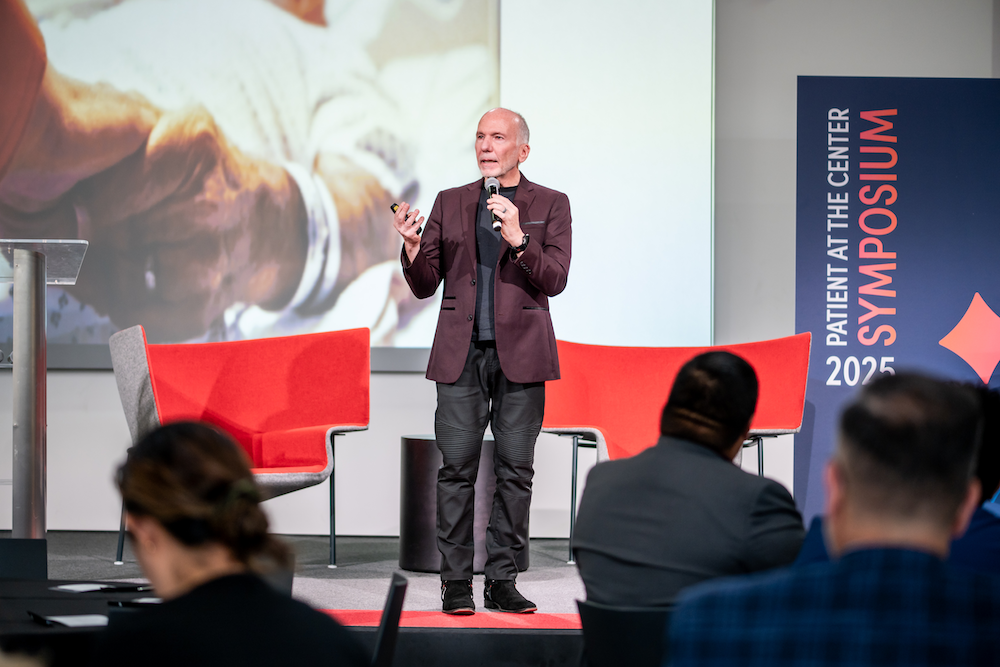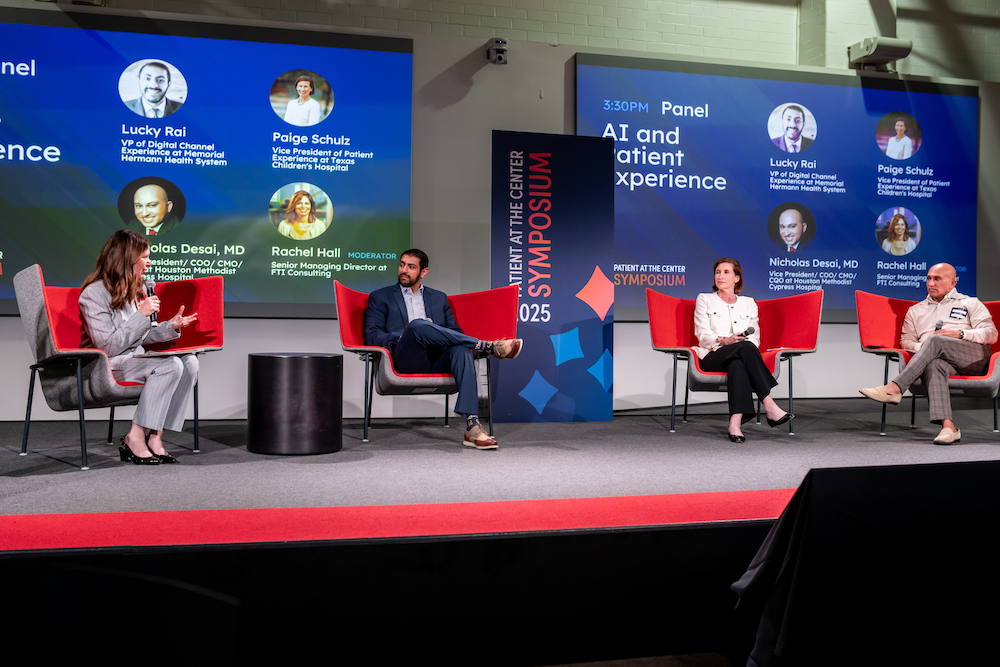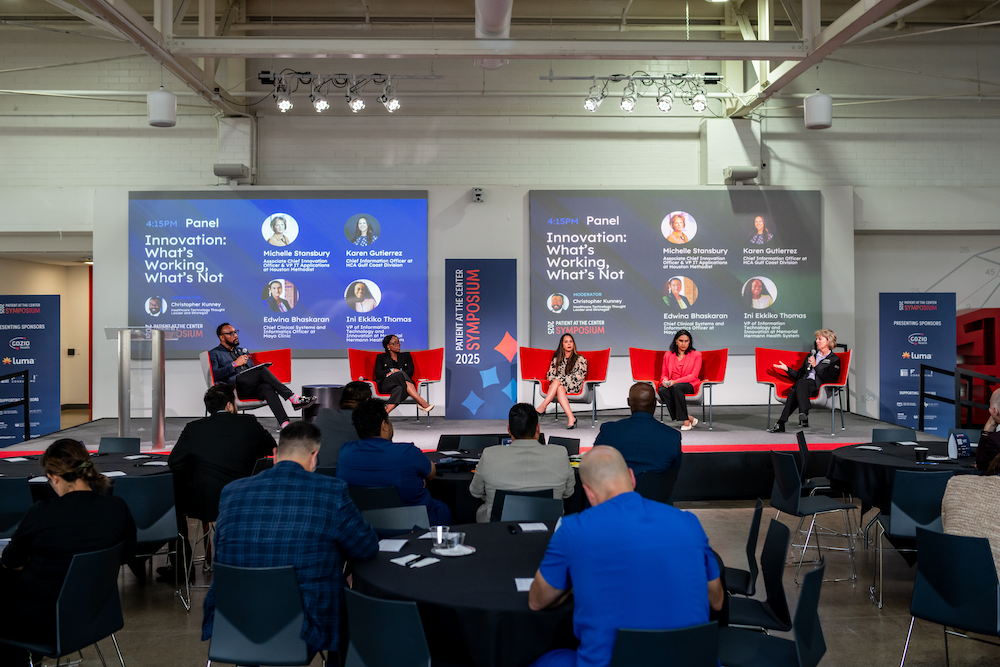From Insight to Action: What We Learned at the Patient at the Center Symposium

.png)
Healthcare leaders from across Houston gathered at the Texas Medical Center of Innovation for the inaugural Patient at the Center Symposium, a half-day event hosted by Gozio Health, FTI Consulting, and Luma Health. Innovators from Baylor College of Medicine, MD Anderson, Memorial Hermann, HCA Healthcare, Houston Methodist, Texas Children’s, and others came together to explore one central question: how can healthcare truly be designed around the patient?
Through open dialogue and shared insights, attendees unpacked what it means to balance clinical, operational, and digital transformation in ways that make healthcare more human without losing sight of the bottom line. The result was a day filled with actionable ideas, candid conversation, and renewed energy for advancing the patient experience across every corner of care.
Redefining Leadership in Patient-Centered Care

The day opened with a keynote from Ed Marx, healthcare leader and author. Ed challenged attendees to think differently about how they connect with patients, emphasizing that you don’t need to be in the C-suite to lead meaningful change. “You can meet patients where they are,” he said, “no matter your title or department.” He provided actionable techniques to get started.
Ed shared practical ways to bring that philosophy to life. He urged organizations to blur the lines between technology and operations so completely that it’s impossible to tell where one ends and the other begins. He spoke about the power of creating shared goals and incentives across departments to break down silos and ensure everyone is working toward the same outcomes.
At the center of his message was a call for customer centricity: bring patients and caregivers directly into the conversation. Transparency and authenticity, he added, are what build trust and momentum and leaders must communicate progress in the language of the business, not just technology. He also emphasized the importance of investing in relationships and scaling leadership, empowering people at every level to own change and work together with purpose.
Ed’s keynote set the tone for the rest of the event: meeting patients where they are starts with aligning people, processes, and technology around a shared purpose.
Connecting Innovation to the Bottom Line
Roberta Schwartz, Executive VP and CIO at Houston Methodist, explored how financial sustainability and digital transformation can move forward together. With healthcare costs climbing, consumer expectations shifting, and margins tightening, she emphasized that every investment in technology should have a clear and measurable purpose.

Roberta encouraged organizations to rethink how they define value. True success, she said, means balancing hard savings, like reducing FTEs, with soft savings that improve workflow, staff satisfaction, and patient experience. Both are essential to building a financially resilient, patient-centered organization.
She shared how Houston Methodist is applying this thinking across its operations. The system’s AI-powered “Care Traffic Control” program has helped reduce emergency codes by 50%, demonstrating how automation can improve safety and efficiency at scale. The health system is also creating “phygital” environments that blend together physical and digital care through technologies like Care AI, Caregility, and Apella to enhance visibility and coordination in acute, ICU, and OR settings. MyChart Bedside TV and ambient listening tools are being used to strengthen communication, while BioButton wearables provide continuous patient monitoring and engagement.
Her closing message resonated deeply with the group: innovation isn’t automatically better. The organizations that will thrive are those that start with a clear outcome in mind and design every process, system, and investment to deliver on that goal.
Implementing AI with Purpose and Patients in Mind

The first panel of the day focused on how AI is reshaping the patient experience. Each panelist shared how their organizations are using AI to make care more personalized, efficient, and connected.
Improving caregiver connection: Paige Schulz, VP of Patient Experience at Texas Children’s, described how they use AI assistants to analyze patient feedback and route insights directly to caregivers, leading to higher Press Ganey scores and greater employee engagement.
Enhancing care coordination: Lucky Rai, VP of Digital Channel Experience at Memorial Hermann, focused on creating more face time between patients and caregivers through ambient listening and improved care coordination. He also discussed how AI can help guide patients toward proactive next steps in their care journey, not just reactive appointments.
Scaling innovation with purpose: Dr. Nicholas Desai, VP/COO/CMO/CQO at Houston Methodist Cypress Hospital, spoke about how they move from pilot to scale with a focus on solving real problems, not chasing new tech. His team follows a “test, learn, scale” model and always asks “why” before “what.”
Their discussion underscored a key shift in measurement: success isn’t just about NPS or HCAHPS anymore. It’s about whether patients feel truly known, understood, and cared for.
Why Innovation Sticks (or Stalls) in Healthcare

The second panel brought together four innovation leaders representing diverse health systems and experiences. Together, they tackled one of the toughest questions in healthcare today: why do some technologies stick while others fall flat?
The conversation quickly turned to the human side of innovation, emphasizing that the success of a technology is heavily impacted by how it is implemented and communicated at an organization.
Engage clinicians early. Edwina Bhaskara, Chief Clinical Systems and Informatics Officer at Mayo Clinic, emphasized the importance of asking nurses directly how tools fit into their day-to-day. In one rollout, her team learned that seamless login and better integration were what truly mattered to patients and staff alike.
Pair innovation with process change. Michelle Stansbury, Associate Chief Innovation Officer at VP of IT Applications at Houston Methodist, shared that even great tech fails without thoughtful process redesign. “Nurses don’t want more tasks,” she said. “Education and workflow planning make adoption possible.”
Consider the context. Karen Gutierrez, Chief Information Officer at HCA Gulf Coast Division, discussed a pilot that connected NICU babies with mothers remotely. This was a success in one hospital, but faltered in another due to higher acuity levels and competing nurse demands.
Timing is everything. Ini Ekiko Thomas, VP of IT and Innovation at Memorial Hermann, noted that their smart room initiative lost momentum when launched alongside a major Epic rollout. The lesson? Even good ideas can stall without focus and bandwidth.
The panelists also explored ambient AI and its impact on care delivery. While all agreed it’s a game changer, end user adoption takes time, training, and trust.
Connection, Collaboration, and What’s Next
The event wrapped with an evening of networking, great food, and meaningful conversation. Attendees had the chance to get their copies of Ed Marx’s book signed and listen to a closing fireside chat featuring Dr. Angela Shippy (AWS), Teresa Tonthat (Texas Children’s Hospital), and Ashley Alexander (Kelsey Research Foundation).
Across every keynote, panel, and conversation, one takeaway rang through loud and clear: ROI data is mandatory. To make patient experience innovation stick, organizations must measure impact, prove value, and adapt continuously.











![The Playbook for a Truly Unified Mobile Experience [Webinar Recap]](https://cdn.prod.website-files.com/6838b4715ff101467a3be25f/6890f731c98a8f107d56b9c2_Webinar%20Image%20Templates-48-Used.png)